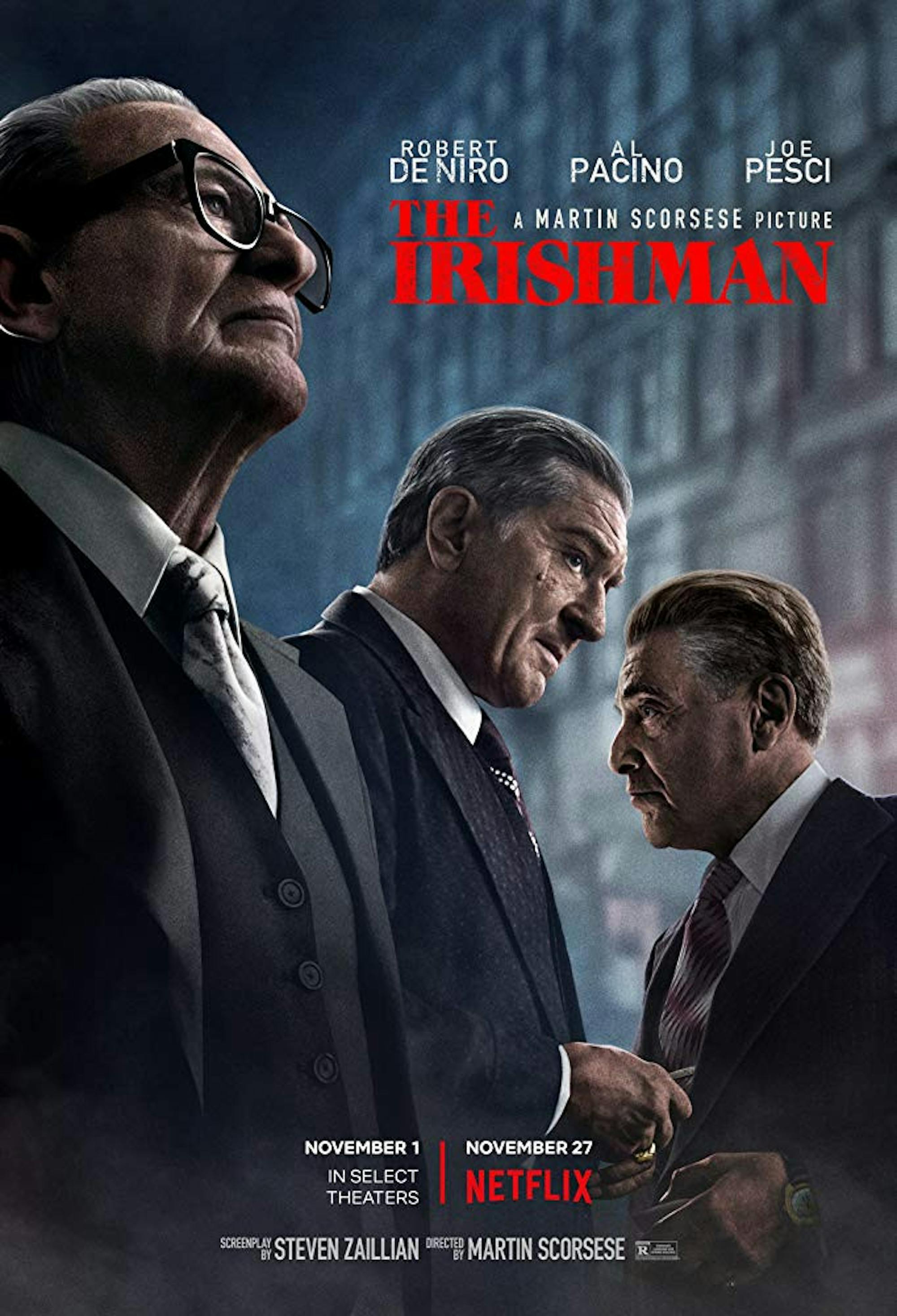With “The Irishman” (2019), director Martin Scorsese has found a story to truly drive home an essential point about living a life of crime. Regardless of your desire for engaging in crimes such as murder, blowing up buildings and gunrunning, you may unfortunately come to find that the Mafioso-lifestyle is merely a temporary high — not a sustainable, enriching or rewarding life path. This point is made in the final shots of two Scorsese crime classics — “Goodfellas” (1990) and “Casino” (1995). In “The Irishman,” this point constitutes the final 30 minutes of the nearly three-and-a-half hour film. It does so thoughtfully and assuredly, in a way that reflects the maturation that aging has bestowed upon the top-billed actors like Robert DeNiro, Joe Pesci and Al Pacino and, of course, Scorsese himself.
Before delving into the refined details of this epic, it is important to note that the autobiographical story told by the real-lifeFrank Sheeran and portrayed in this film is not a universally agreed upon truth regarding the disappearance of legendary union leader Jimmy Hoffa. For some information on the near 45-year debate surrounding his death, first read through a recent Slate Magazine piece that denies parts of Sheeran’s story, and then read the response to said article by the publisher of the book that the film is based on.
The film is a masterpiece, and it is more than worthy of being heralded among the mob movie greats — “The Godfather Part II” (1974), “Once Upon a Time in America” (1984), “Goodfellas" and “The Departed” (2006), to name a few.
Scorsese dabbles in a bit of artful deception to start off the film, with a nod to his oft-discussed “Goodfellas” shot in which a Steadicam follows Ray Liotta’s character, Henry Hill, through the exuberant Copacabana nightclub. Scorsese deploys the same technique in “The Irishman's" opening shot, taking us through a nursing home. Aided by the doo-wop classic “In The Still of the Night” (1956), the camera makes its way to Frank Sheeran, the now-decrepit protagonist. This opening sequence gives off two impressions about the direction the movie is heading in. One is that, like in “Goodfellas,” we are about to be taken through a sprawling, lavish time in a mobster’s life, and two is that the camerawork and soundtrack will play a significant role in playing up the extravagant aspects of mob life.
Au contraire, the rest of the film does not give the impression that our protagonist is the boisterous spendthrift that “Goodfellas’" Henry Hill is. Rather, DeNiro’s Frank Sheeran is quiet and tepid, though just as cold-blooded as Hill. Sheeran’s ease in the role of a killer is likely a result of him having fought in World War II. The film does not employ all that much more notable camera technique, nor does it contain any other soundtrack-driven scenes.
The film is actually quite matter-of-fact in its depiction of the East Coast crime and labor union intersection. When a mobster or union member with mob ties is introduced, Scorsese freezes the picture to tell us just the person’s name and the way they were murdered in real life. What “The Irishman” lacks in style, however, it more than makes up for in substance. There are three time periods shown — all varying in timespan covered. The 80-something-year-oldFrank Sheeran recounts a couple days in the summer of 1975 that lead up to Jimmy Hoffa’s disappearance and the day of, while the sight of a certain gas station causes the 1975, 50-something-year-oldFrank Sheeran to reflect back on his multi-decade climb through the crime world. The timelines seamlessly weave in and out of each other and serve unique purposes and payoffs.
Within these timelines are compelling plotlines of family, dual loyalties, power struggles, deceit and everything else one would expect in a crime epic. These plotlines are never mutually exclusive — Frank’s dual loyalty to Pesci’s crime family boss Russell Bufalino and Pacino’s Jimmy Hoffa has a direct effect on Frank’s daughter Peggy.Frank’s role makes him the middleman in a late scene when Hoffa tries to regain power in the labor unions from Bufalino and other connected crime bosses, and Frank’s loyalty is thrown into question when he finds out that the crime bosses have tricked Hoffa by “agreeing” to an amicable meeting.
The layering of the plots in each timeline makes the film a world-class slice of cake, each bite equally rich but never overfilling. Regardless of which emotion a specific moment in the plot is trying to make the audience feel, seeing Scorsese’s directorial techniques and the brilliance that screenwriter Steven Zaillian has concocted makes the entire film an absolute joy to watch.
That being said, the final half hour is absolutely gut-wrenching. Frank Sheeran finds himself all alone, his life having amounted to essentially nothing and his living family not wanting to interact with him. He deserves it, after all — his violent job alienated him from his daughters’ past possible reconciliation, he killed one of the two people he was closest to and he spent much of his old age in prison. Our hearts break when we consider all that’s been shown from the perspective of his daughter — Peggy. Peggy has suffered for years, having seen her father break a grocer’s hand and finding out that he killed her favorite family friend. This perspective shows that Scorsese has found a new angle to explore, and it is why “The Irishman” doesn’t just feel like a retread of his old stuff.
“The Irishman” is a true cinematic spectacle. Try to catch it in theaters, not just on Netflix.
'The Irishman': A new, mature crime classic

A promotional poster for 'The Irishman' (2019) is pictured.
Summary
"The Irishman" captures Scorsese's mastery as a filmmaker, sealing its fate as one of the mob movie greats.
5 Stars





